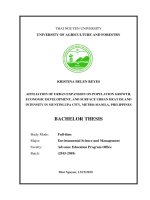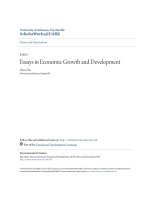Economic growth and economic development 350
Bạn đang xem bản rút gọn của tài liệu. Xem và tải ngay bản đầy đủ của tài liệu tại đây (133.87 KB, 1 trang )
Introduction to Modern Economic Growth
continuous. From the definition (7.31), at all t where yˆ (t) is continuous, V (t, x) will
also be differentiable in t. Moreover, an envelope theorem type argument also implies
that when yˆ (t) is continuous, V (t, x) should also be differentiable in x (though the
exact conditions to ensure differentiability in x are somewhat involved). Second,
(7.37) is a partial differential equation, since it features the derivative of V with
respect to both time and the state variable x. Third, this partial differential equation
also has a similarity to the Euler equation derived in the context of discrete time
dynamic programming. In particular, the simplest Euler equation (6.22) required
the current gain from increasing the control variable to be equal to the discounted
loss of value. The current equation has a similar interpretation, with the first term
corresponding to the current gain and the last term to the potential discounted loss
of value. The second term results from the fact that the maximized value can also
change over time.
Since in Theorem 7.9 there is no boundary condition similar to x (t1 ) = x1 , we
may expect that there should be a transversality condition similar to the condition
that λ (t1 ) = 0 in Theorem 7.1. One might be tempted to impose a transversality
condition of the form
(7.38)
lim λ (t) = 0,
t→∞
which would be generalizing the condition that λ (t1 ) = 0 in Theorem 7.1. But this
is not in general the case. We will see an example where this does not apply soon.
A milder transversality condition of the form
(7.39)
lim H (t, x, y, λ) = 0
t→∞
always applies, but is not easy to check. Stronger transversality conditions apply
when we put more structure on the problem. We will discuss these issues in Section
7.4 below. Before presenting these results, there are immediate generalizations of
the sufficiency theorems to this case.
Theorem 7.11. (Mangasarian Sufficient Conditions for Infinite Horizon) Consider the problem of maximizing (7.28) subject to (7.29) and (7.30), with
f and g continuously differentiable. Define H (t, x, y, λ) as in (7.12), and suppose
that a piecewise continuous solution yˆ (t) and the corresponding path of state variable
336









